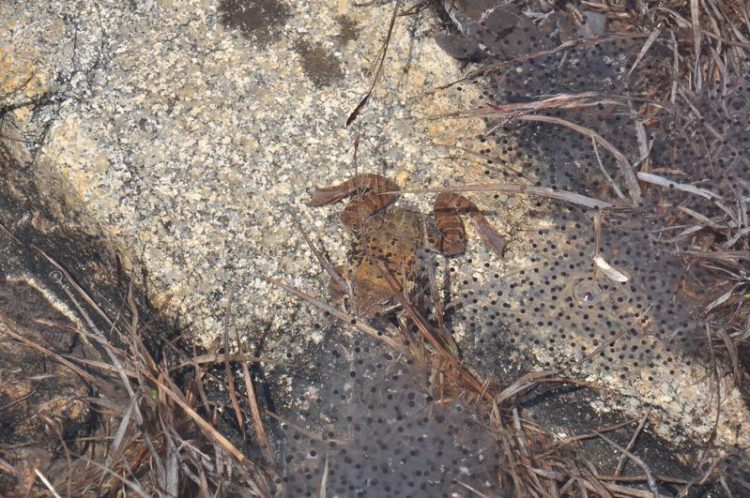The disease pyramid: environment, pathogen, individual and microbiome

The microbiome is also an important part of the immune response in amphibians. Dirk Schmeller
Biotic and abiotic environmental factors have a strong influence on the dynamics of diseases in humans and animals. In their study, the researchers focus on an important component: the microbiome.
The individual microbiome of a living being is a vital component of immunity. Especially on the skin and in the bowel, i.e. directly at the interface between the individual and pathogens, endogenous bacteria and viruses are highly active.
The international team presents the concept of a disease pyramid with the four cornerstones of environment, pathogen, host and microbiome. For the first time, the different functions of the microbiome are taken into account.
The researchers illustrate this by using the amphibian disease chytridiomycosis caused by the fungal pathogen Batrachochochytrium dendrobatidis.
“The microbiome of living organisms is highly variable. It is only in recent years that researchers have succeeded in using genetic methods to determine the totality of microorganisms. We are now only gradually beginning to understand their role in health prophylaxis and how they interact, for example, with the environmental microbiome, pathogens and the host,” explains IGB researcher Dr. Adeline Loyau, who led the study.
Diversity of microbiome and habitats strengthens resistance:
The authors emphasise that more diverse microbiomes can make the host more resistant to pathogens because they are better able to keep potential pathogens at bay. The study also shows that individuals who inhabit complex and therefore species-rich habitats have a lower mortality rate.
The team shows that the microbiome can act very specifically against pathogens: The symbiotic skin bacterium Janthinobacterium spp. forms an anti-fungal agent as a metabolic product and thus prevents infection with Batrachochytrium dendrobatidis.
Climate change modifies the microbiome of amphibians:
It is assumed that the adaptability of the microbiome can in turn increase the organism’s adaptability to environmental influences. There are several examples of this in the animal kingdom. However, environmental changes such as climate change can also throw the microbiome out of balance: “A microbiome in equilibrium can protect against infection in changing environmental conditions,” explains the study’s first author, Adriana P. Bernardo-Cravo from the Université de Toulouse and the UFZ.
“However, it is also shown that environmental changes – especially temperature – have a significant impact on the composition of the microbiome, and thus on the resistance of amphibians to Batrachochytrium dendrobatidis. Climate change will significantly change the distribution of this fungal disease in amphibians,” the ecologist predicts.
Axa-Professor Dirk Schmeller from the Université de Toulouse, further explains: “We have to be aware that climate change and biodiversity loss are stress factors for ecosystems, for humans, for animals and for the microbiome. Our research shows that if the different axes of the disease pyramid are destabilised, new infectious diseases can be expected, including for humans.”
The presented concept of the disease pyramid is therefore trend-setting for research on human-animal-plant-environment interactions and the resulting risks for biodiversity and humans.
Supplementary information:
The decline of amphibians, the most endangered vertebrates, causes cascade effects in the food webs and can change the environmental balance in the long term, for example water quality or the occurrence of pests and pathogens. In some ecosystems, such as the North American arboreal forests, amphibians are the most common terrestrial vertebrates. There they help regulate the carbon balance. The fungus Batrachochochytrium dendrobatidis is responsible for the decline of over 500 frog species worldwide. It damages the amphibians’ skin and disrupts its basic functions, which ultimately leads to cardiac arrest.
About the Leibniz-Institute of Freshwater Ecology and Inland Fisheries (IGB):
“Research for the future of our freshwaters” is the mission of the Leibniz-Institute of Freshwater Ecology and Inland Fisheries (IGB). IGB is Germany’s largest and one of the leading international research centres for freshwaters. It combines basic and preventive research, trains young scientists and advises decision-makers and society for a sustainable freshwater management. Its key research activities include the long-term development of lakes, rivers and wetlands and the effects of climate change, the renaturation of ecosystems, the conservation of aquatic biodiversity, and technologies for sustainable aquaculture. Work is conducted in close cooperation with universities and research institutions from the Berlin-Brandenburg region as well as worldwide. IGB is a member of the Forschungsverbund Berlin e. V., an association of eight research institutes of natural sciences, life sciences and environmental sciences in Berlin. The institutes are members of the Leibniz Association. https://www.igb-berlin.de/en
Media information at a glance: https://www.igb-berlin.de/en/newsroom
Subscribe to IGB’s newsletter: https://www.igb-berlin.de/en/newsletter
IGB on Twitter: https://twitter.com/LeibnizIGB
IGB on Facebook: https://www.facebook.com/IGB.Berlin/
Dr. Adeline Loyau
Department Experimental Limnology
Leibniz-Institute of Freshwater Ecology and Inland Fisheries (IGB)
loyau(at)igb-berlin.de
Dr. Dirk Schmeller
Axa Chair for Functional Mountain Ecology
École Nationale Supérieure Agronomique de Toulouse, Toulouse, France.
dirk.schmeller(at)toulouse-inp.fr
Bernardo-Cravo, A., Schmeller, D.S., Chatzinotas, A., Vredenburg, V.T., Loyau, A., 2020. Environmental Factors and Host Microbiomes Shape Host-Pathogen Dynamics. Trends in Parasitology 36, 29-36. https://doi.org/10.1016/j.pt.2020.04.010
Media Contact
More Information:
https://www.igb-berlin.deAll latest news from the category: Ecology, The Environment and Conservation
This complex theme deals primarily with interactions between organisms and the environmental factors that impact them, but to a greater extent between individual inanimate environmental factors.
innovations-report offers informative reports and articles on topics such as climate protection, landscape conservation, ecological systems, wildlife and nature parks and ecosystem efficiency and balance.
Newest articles

Properties of new materials for microchips
… can now be measured well. Reseachers of Delft University of Technology demonstrated measuring performance properties of ultrathin silicon membranes. Making ever smaller and more powerful chips requires new ultrathin…

Floating solar’s potential
… to support sustainable development by addressing climate, water, and energy goals holistically. A new study published this week in Nature Energy raises the potential for floating solar photovoltaics (FPV)…

Skyrmions move at record speeds
… a step towards the computing of the future. An international research team led by scientists from the CNRS1 has discovered that the magnetic nanobubbles2 known as skyrmions can be…





















